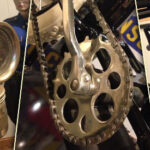Pioneer Cemetery, nestled almost in the shadow of the Dallas Civic Center, is more than just a burial ground; it’s a repository of Dallas history, echoing with stories of the city’s founders and early residents. Among its weathered headstones lie tales of love, loss, and legacies that shaped the very fabric of Dallas, Texas. One such story, etched faintly on a timeworn stone, belongs to a remarkable woman whose life of compassion continues to resonate through time.
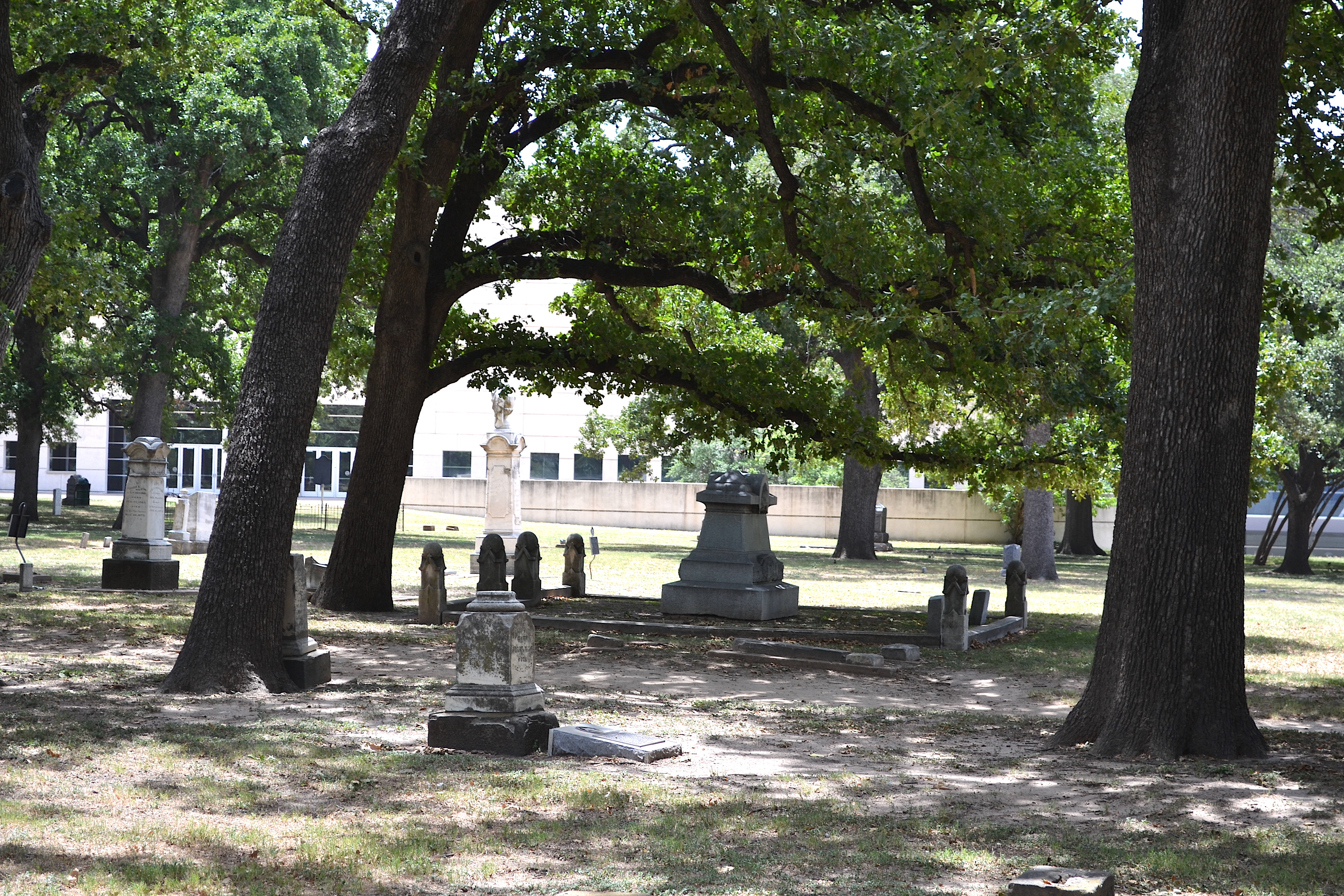
An encompassing view of Pioneer Cemetery Dallas, illustrating its location near the Dallas Civic Center and the variety of historical gravestones.
Juliette Abbey Peak, born in Warsaw, Kentucky, in 1837, was one of thirteen children. Her family’s arrival in East Dallas in 1855 marked the beginning of a significant chapter in Dallas’s development. Her father, Colonel Jefferson Peak, played a pivotal role in shaping the landscape, developing his farm and plotting streets that would become arteries of the burgeoning city. Streets like Peak, Worth, Junius, Carroll, Flora, Harwood, Field, and Victor stand as enduring tributes to the Peak family’s contributions. Beyond urban development, the Peaks were instrumental in establishing the Christian Church in Dallas and Fort Worth, laying the foundation for religious life in the area and founding the first Protestant church in Dallas, which branched into Central Christian Church and East Dallas Christian Church.

A historical portrait of Juliette Fowler, Dallas’s first May Queen, highlighting her youthful beauty and the era in which she lived.
The Beautiful Bride and Benevolent Widow of Dallas
Juliette Peak, known for her beauty and kindness, holds the distinction of being Dallas’s first May Queen. In 1857, she married Archibald Young Fowler, an attorney, embarking on what seemed like a promising future. However, tragedy struck early. Their two children, Ada and A.Y. Jr., both passed away in infancy, and further sorrow befell Juliette when her husband died from wounds sustained in a dispute with the Tarrant County sheriff. You can delve deeper into the details of this incident here. Widowed at the young age of 23 and pregnant with her second child, Juliette returned to Dallas, choosing to remain unmarried and dedicate her life to the service of others.
Juliette Fowler channeled her grief into extraordinary acts of compassion. She adopted an abandoned boy found in her church, offered respite to Texan female teachers by building cottages in Chautauqua, and cared for her aging parents. Her vision extended to creating a haven for orphans and widows, a dream she meticulously researched and planned.
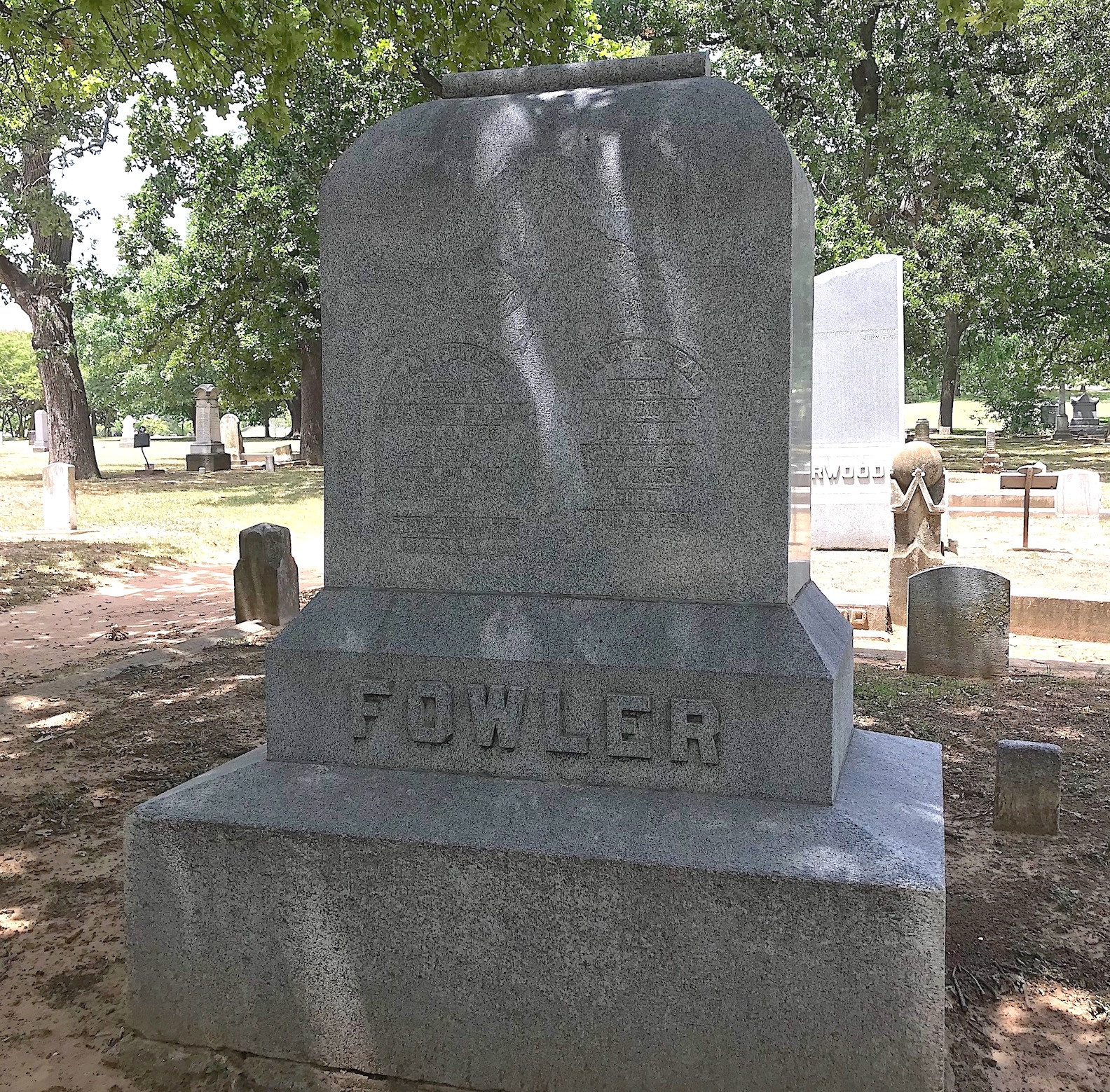
The weathered gravestone of Juliette Fowler at Pioneer Cemetery in Dallas, situated next to her husband Archibald Fowler’s, marking her final resting place.
At 52, Juliette’s life was cut short when she succumbed to an ear infection in New York in 1889, where she sought medical treatment. Her will, however, ensured her legacy of giving would endure. She bequeathed $4,000 and 15.5 acres of East Dallas land to establish a home for orphans and widows. This act of profound generosity cemented her status as Dallas’s first major philanthropist. Juliette Fowler Communities, a testament to her enduring vision, continues to thrive today, offering senior living and transitional housing for young girls.
Rev. Young: A Street Name Legacy in Dallas
Among the notable figures at Pioneer Cemetery is Rev. William Ceiton Young, whose newly refurbished marker stands as a prominent feature. Whether his original marker was lost to time or damage, the fresh stone signifies his lasting importance.
Rev. Young’s presence in Pioneer Cemetery aligns with his deep Masonic connections, predating his arrival in Dallas from Arkansas. He served as Master of Tannehill Lodge (1870-1871) and as Chaplain multiple times (1867, 1868, 1888, 1889). His Masonic dedication extended to High Priest of Dallas Chapter No. 47 (1868, 1873, 1886). This commitment to Freemasonry was carried on by two of his sons.
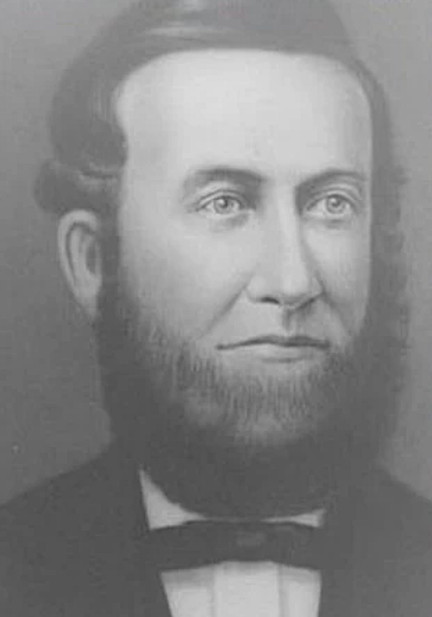
A distinguished portrait of Rev. William Ceiton Young, highlighting his role in Dallas’s history and the naming of Marilla Street after his mother.
Born in Trigg County, Kentucky, in 1827, Rev. Young entered the Methodist ministry in 1849, serving in the Memphis Conference for three years. From 1852 to 1865, he pastored churches in Arkansas and Louisiana and served as a Missionary Chaplain to the Arkansas Confederate Cavalry.
Moving to Dallas in 1865 with his wife, Mary Pipkin, whom he married in Arkansas in 1857, Rev. Young became deeply involved in civic life. He served as Dallas County District Clerk (1867-1868) and as a three-term alderman for the Fourth Ward, which encompassed the Young family home, “The Cedars,” during the 1870s.
As alderman, Rev. Young was instrumental in naming many streets in the Fourth Ward. Marilla Street honors his mother, Canton Street his Kentucky birthplace, Cadiz Street the Trigg County seat, Harwood Street Dallas County clerk and fellow Mason Alexander Harwood, and Akard Street Masonic brother W.C.C. Akard.

The well-maintained gravestone of Rev. William Ceiton Young at Pioneer Cemetery, Dallas, reflecting his long life and contributions to the city.
Rev. Young lived a long and impactful life, passing away in 1921 at the age of 93. The proximity of Pioneer Cemetery to the intersection of Marilla and Young Streets is a fitting geographical tribute to his enduring legacy in Dallas.
The Deaths of Lillie and Alma Young: A Family Tragedy
The Young family’s story at Pioneer Cemetery also includes profound sorrow. Like many families of the era, Rev. Young and Mary experienced the pain of losing children. In 1885, they suffered the deaths of two children, Alma and Lillie.

An obituary clipping for Alma Young from the Dallas Daily Herald (June 12, 1885), detailing his sudden death from “congestive fever” at age 23.
Alma Young, born in 1861, was working at a grocery store at the time of his death. Previously employed at the Dallas Herald, Alma fell ill suddenly on June 10, 1885, complaining of a sore throat. His condition worsened rapidly, and he died the next day from what was diagnosed as “congestive fever,” a term then used for malaria. He was only 23.
Lillie, just 15, passed away a few months later on September 19. Her obituary mentions her sudden death but not the cause, noting the profound impact on her young peers with the poignant statement, “If Lillie has gone, how soon may we follow!”
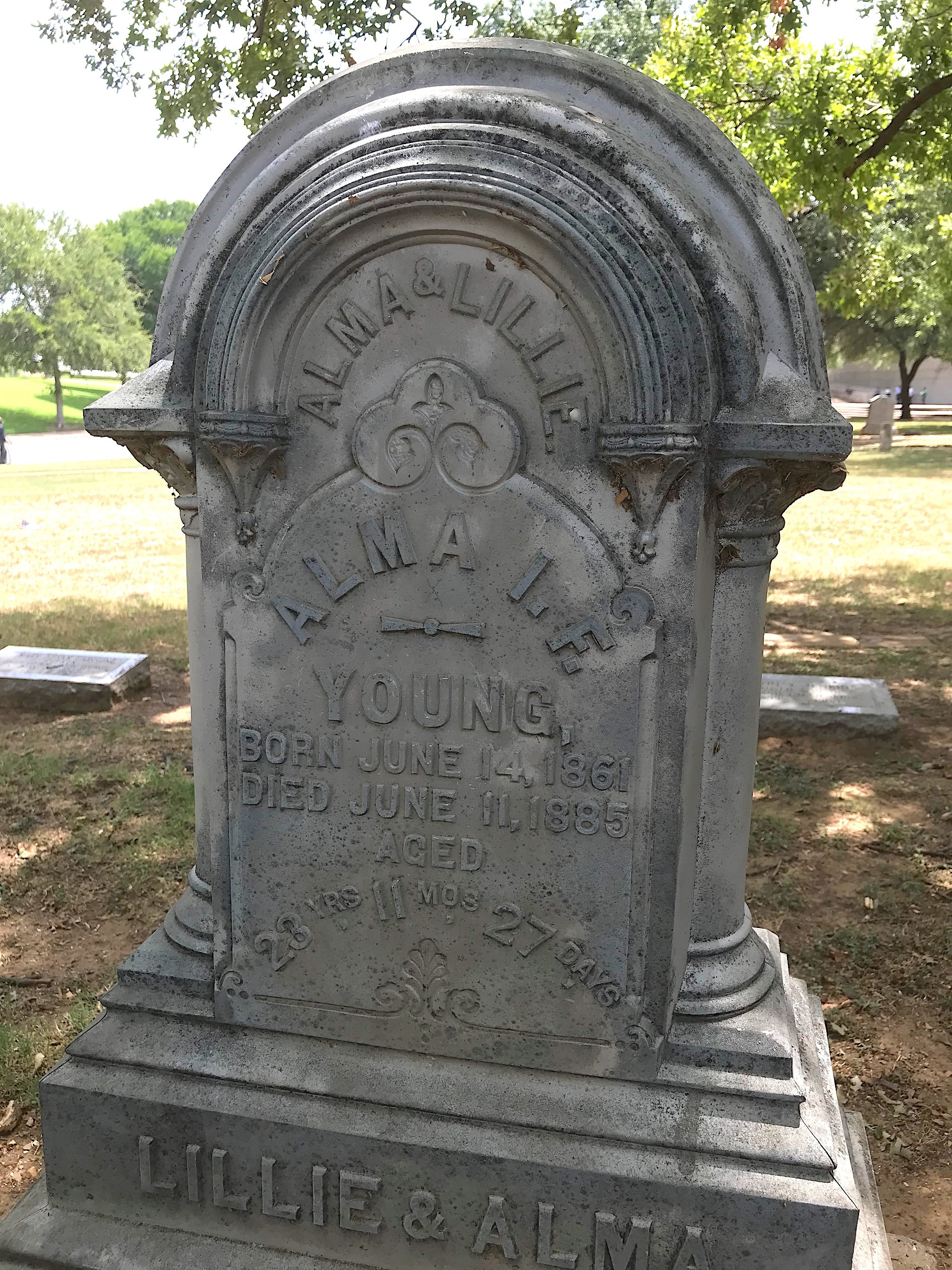
The shared white bronze marker for siblings Alma and Lillie Young in Pioneer Cemetery, Dallas, unique for its material and commemorating their intertwined loss.
Alma and Lillie share a single white bronze marker, a unique feature within Pioneer Cemetery. Its silver hue, less common than the greenish-gray patina typically seen on white bronze, makes it a distinctive memorial to the siblings.
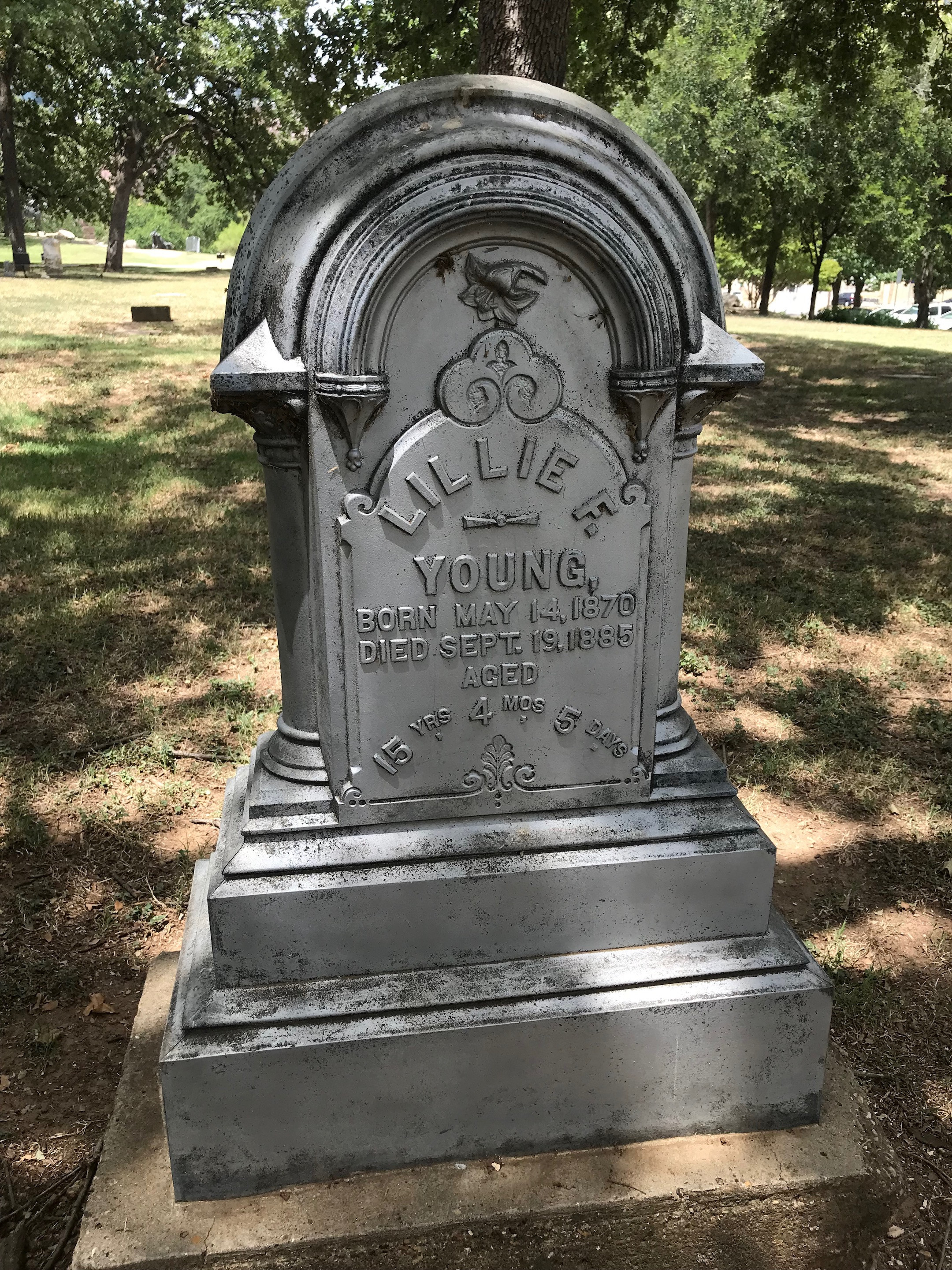
A closer view of Lillie Young’s name on the white bronze marker, emphasizing the sudden and unexplained nature of her young death.
John J. Eakins: From Pioneer Cemetery to Dallas Heritage Village
The Eakins family plot in Pioneer Cemetery is distinguished by the cemetery’s only monument featuring a statue. This monument honors John J. Eakins, his wife Ophelia, and several of their children, representing their significant place in Dallas history.
John J. Eakins, born in Henderson Co., Kentucky, in 1822, arrived in Dallas in 1849 after serving as a captain in the Mexican War (1847-1848). In 1850, he married Ophelia Crutchfield, also a Kentucky native. Ophelia’s obituary recounts they had eight children together.

The Eakins family plot at Pioneer Cemetery in Dallas, showcasing the unique statue monument and the family’s prominent status.
Eakins is perhaps best remembered for selling, or in some accounts donating, 60 acres of land to the City of Dallas for $600. This land became Old City Park, now known as Dallas Heritage Village, a preserved piece of Dallas history.
Initially envisioned as an “aesthetic, driving park” for Dallas residents to enjoy leisurely carriage rides, City Park evolved to house Dallas’s first zoo. It was intended as a place for recreation and social display.
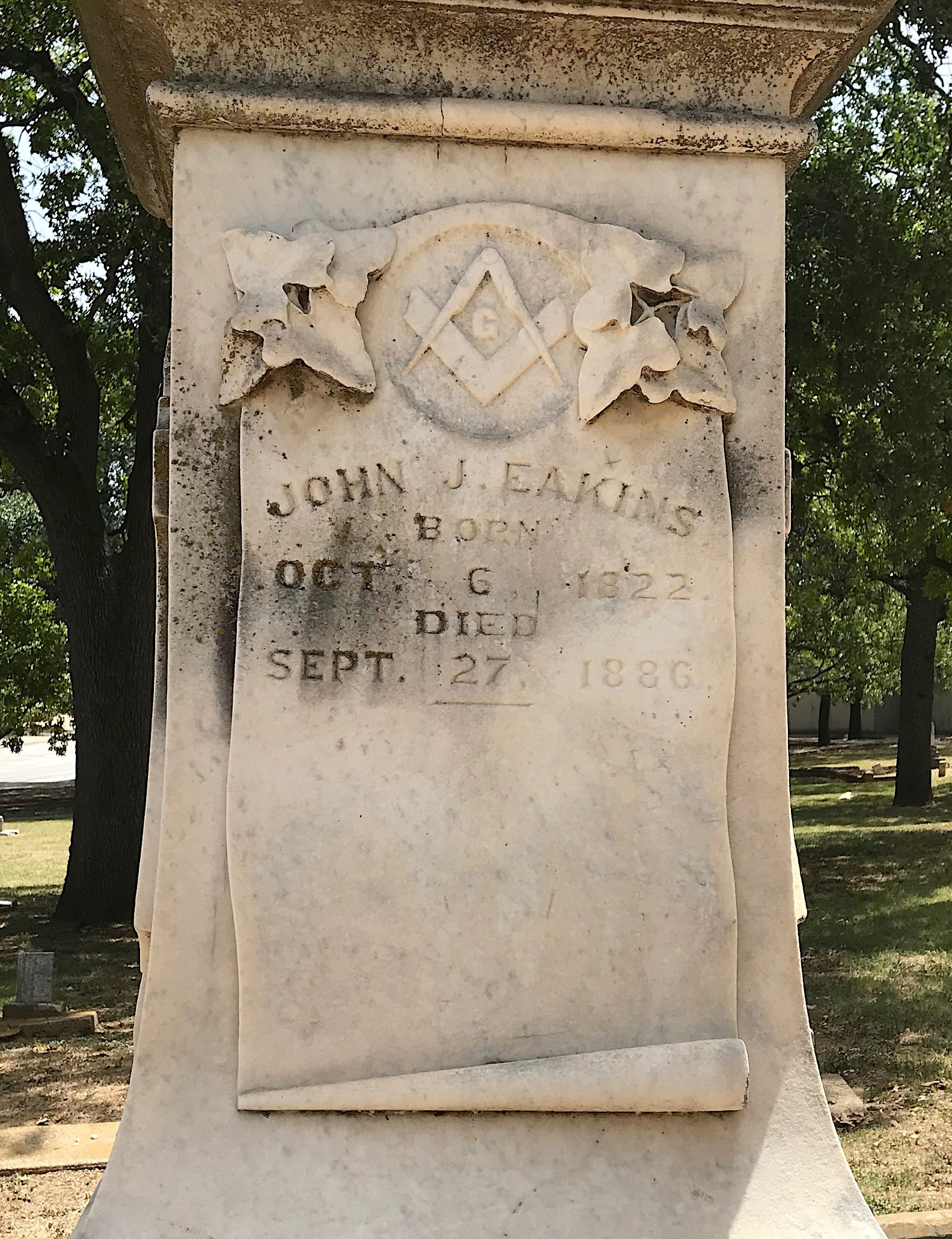
An inscription detail on the Eakins family monument, possibly indicating John J. Eakins’s Masonic affiliation and his connection to this Masonic burial ground.
Interestingly, historical records show that naming City Park as Eakins Park was suggested twice – after John Eakins’s death in 1887 and again in 1902 – but both proposals were declined.
The monument lists the names of five of John and Ophelia’s children who died young. It remains unclear which children are interred in the plot. Ophelia outlived most of her children, passing away in 1903 at 72, survived only by her son Edwin. Despite her obituary stating her burial in the plot, her name is not inscribed on the monument. Edwin, who died in 1914 and is also buried there, similarly lacks inscription on the monument.
Remembering the Confederate Monument
During a visit to Pioneer Cemetery in July 2018, a large monument erected by the United Daughters of the Confederacy in 1896 stood in honor of Texas Confederate dead. Many Confederate soldiers from the Civil War are buried within Pioneer Cemetery. Designed by Frank Teich and originally placed in Old City Park in 1897, the monument was relocated to Pioneer Cemetery in 1961.
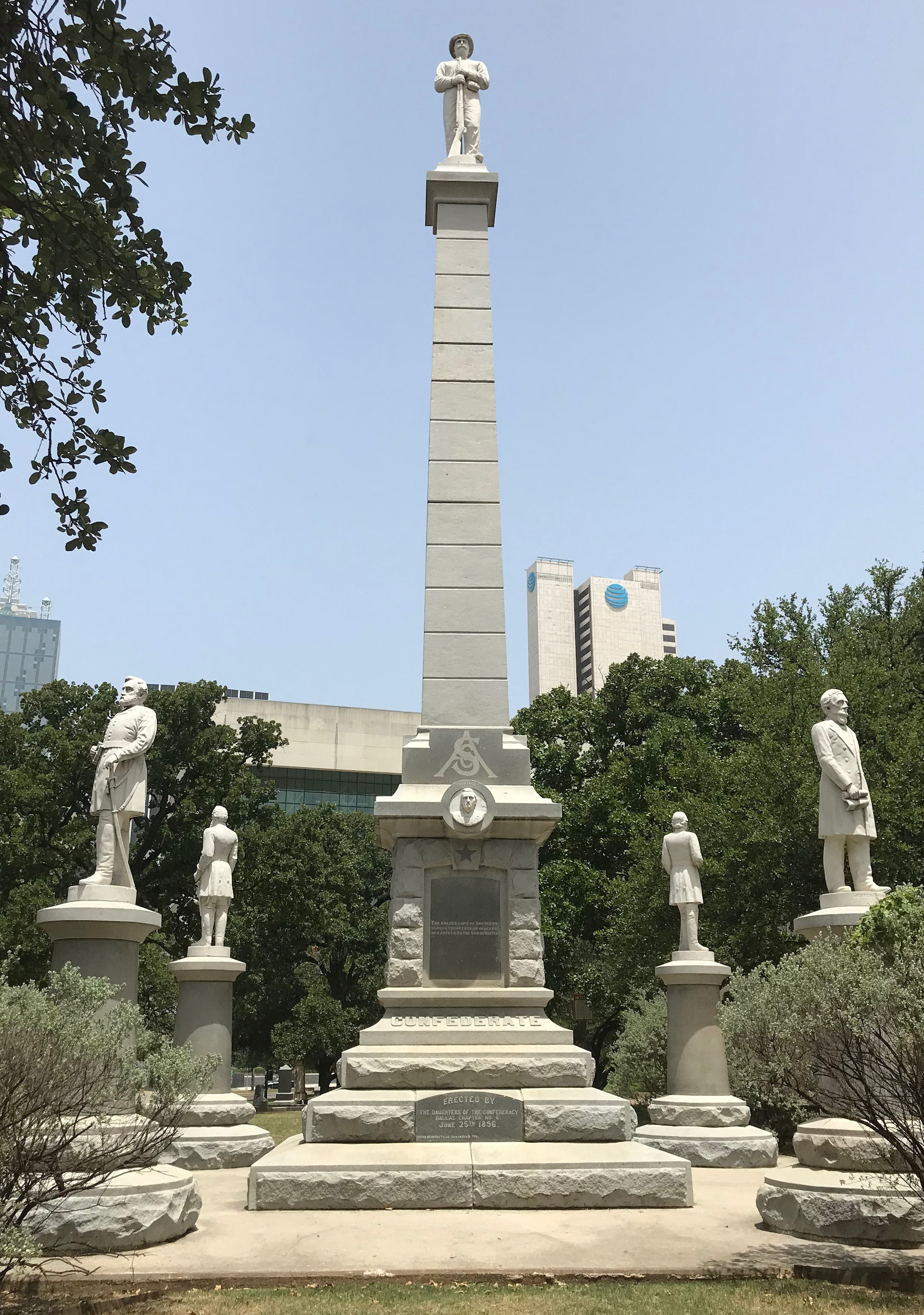
The former Confederate monument at Pioneer Cemetery in Dallas, featuring a towering obelisk, Confederate soldier statue, and figures of Confederate leaders, prior to its removal.
Efforts to remove the monument, underway for some time, culminated in June 2020 when dismantling began. It is currently stored at Hensley Field, part of the Grand Prairie Armed Forces Reserve Complex and the former Dallas Naval Air Station site, marking a shift in how Dallas confronts its historical narratives.
Our Dallas cemetery exploration also included Greenwood Memorial Park and Mausoleum, which will be featured in a future article.
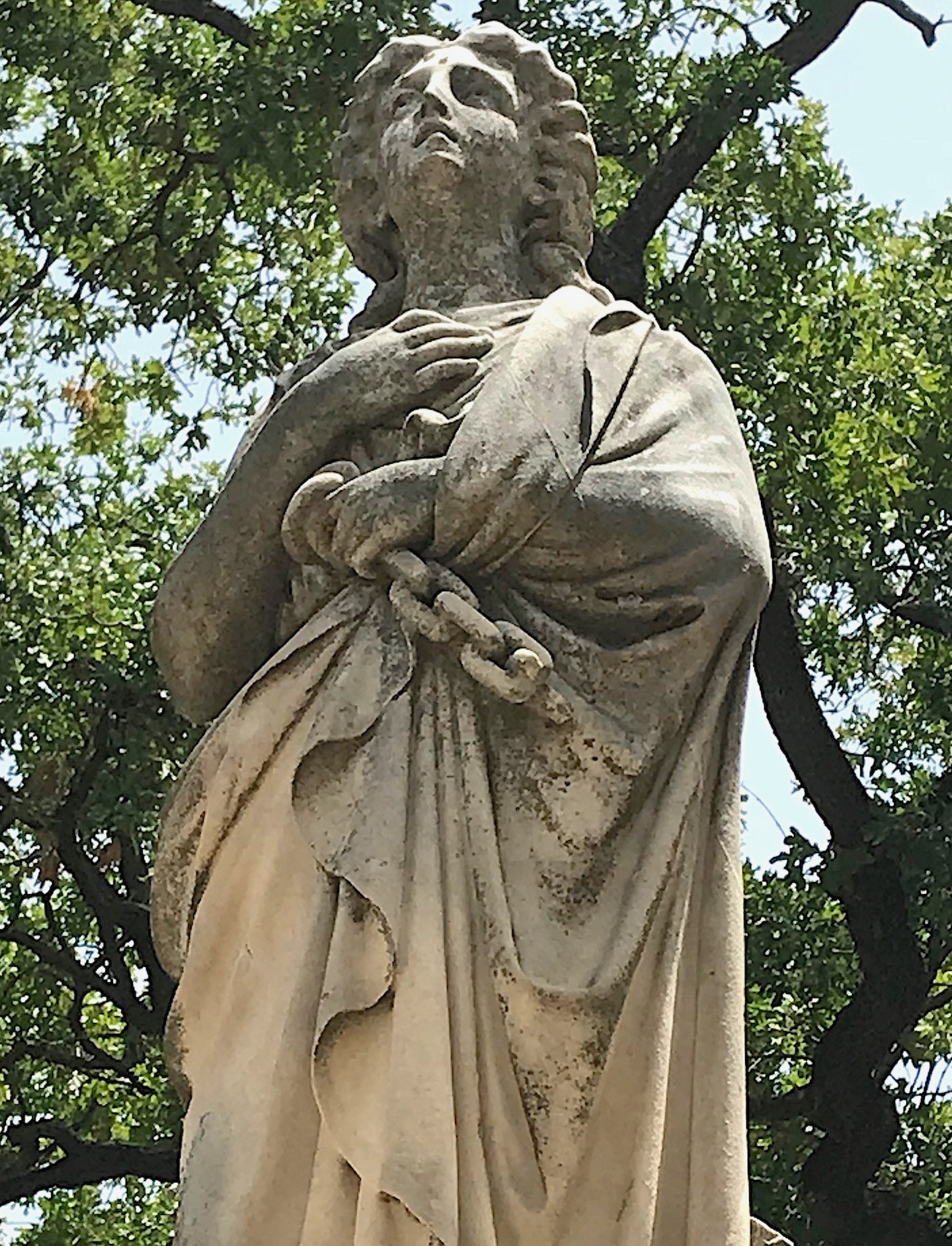
A detailed view of the statue atop the Eakins family monument in Pioneer Cemetery, Dallas, emphasizing the artistry and personal touch of this unique memorial.
Pioneer Cemetery in Dallas serves as a poignant reminder of the individuals who shaped the city. From philanthropists like Juliette Fowler to civic leaders like Rev. Young and pioneers like John J. Eakins, their stories are etched in stone, offering valuable insights into Dallas’s rich and complex past. Exploring Pioneer Cemetery is truly a journey through time, connecting us with the lives and legacies of those who came before.


